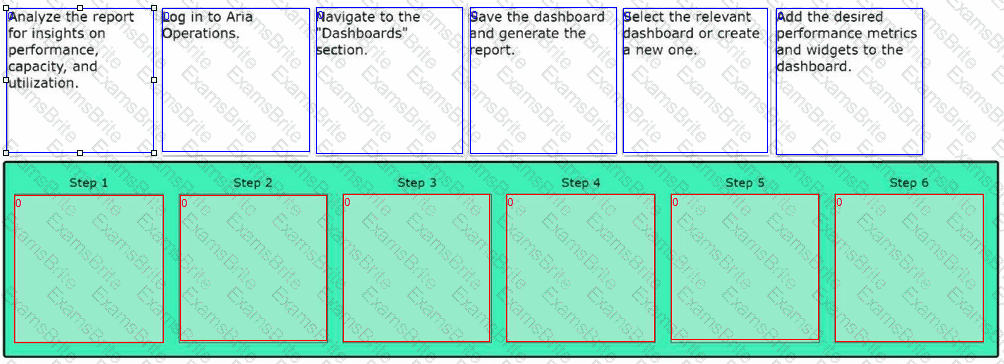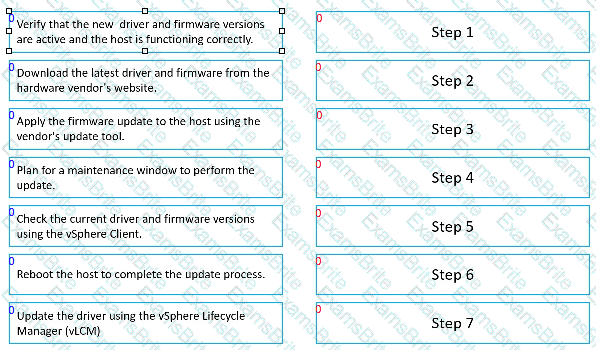
VMware Cloud Foundation 5.2 Administrator
Last Update Nov 30, 2025
Total Questions : 173
We are offering FREE 2V0-11.25 VMware exam questions. All you do is to just go and sign up. Give your details, prepare 2V0-11.25 free exam questions and then go for complete pool of VMware Cloud Foundation 5.2 Administrator test questions that will help you more.



Which two steps should an administrator perform to configure the backup of the VMware Cloud Foundation (VCF) SDDC Manager and NSX components to allow them to be recovered in the event of a full site failure? (Choose two.)
Which tool is most appropriate for diagnosing and resolving a disk failure when using VMware vSAN with Deduplication enabled?
During the deployment of a VI workload domain using SDDC Manager, an administrator encounters issues with host configuration.
Which three steps should be followed to troubleshoot and resolve the configuration issues? (Choose three.)
An administrator has been tasked with deploying a new VMware Cloud Foundation (VCF) environment and is preparing the physical hosts that will be used for the management domain. The administrator has completed the following tasks for all of the physical hosts:
The required version of ESXi has been installed.
Networking has been configured for the ESXi management interface.
DNS entries have been created for forward and reverse name resolution.
NTP has been configured and the time synchronized with a centralized time source.
VLAN 10 has been presented to the ESXi hosts on the physical network infrastructure for the VCF ESXi management network.
A combination of which two additional tasks must the administrator complete before starting the bring-up of the management domain? (Choose two.)
An administrator has been tasked with expanding an existing VMware Cloud Foundation environment by adding a new workload domain. The environment currently has one management domain and one VI workload domain.
What options are available to the administrator for deploying NSX in the second VI workload domain?
An organization is planning to manage a diverse set of databases across multiple VMware Cloud Foundation (VCF) environments using Data Services Manager.
Which three capabilities of Data Services Manager would help the organization managing these databases efficiently? (Choose three.)
Which VMware vSphere feature provides the ability to define and apply datastore capabilities to ensure virtual machines meet specific performance and availability requirements?
What are three prerequisites for deploying an NSX Edge cluster in a VMware Cloud Foundation (VCF) solution? (Choose three.)
An administrator is using VMware Aria Automation to automate the provisioning of virtual machines in their VMware Cloud Foundation environment. They notice that the automation workflows are failing frequently and want to troubleshoot the issue.
What step should the administrator take in VMware Aria Operations for Logs to diagnose the cause of the automation workflow failures?
An administrator configures a Local Content Library on vCenter Server A, enables publishing, and creates Subscribed Content Libraries on vCenter Server B and vCenter Server C using the publishing URL. However, the contents of the subscribed libraries on vCenter B and C are not synchronizing with the source library on vCenter A.
Which step should the administrator take to troubleshoot the issue?
DRAG DROP
Arrange the steps in the correct order to generate a performance report in Aria Operations.

An administrator needs to configure Network IO Control (NIOC) on a Virtual Distributed Switch (VDS) to prioritize storage traffic over other types of traffic.
Which two steps should be followed? (Choose two.)
An organization has 3 data center sites and is implementing a solution to achieve a Recovery Point Objective (RPO) of 0 to ensure continuous availability of storage in the event of a single site failure. The sites are connected via a high bandwidth/low latency link.
Which two VMware Cloud Foundation (VCF) components can be used to support this capability? (Choose two.)
An administrator has been tasked with adding a new VI workload Domain to an instance of VMware Cloud Foundation (VCF).
The administrator only has two prepared ESXi host servers showing in SDDC Manager.
The new VI Workload Domain must use vSphere Lifecycle Images.
Which three supported principal storage options are available to the administrator when configuring the new VI Workload Domain? (Choose three.)
What is the primary purpose of configuring VM storage policies in a VMware vSphere environment?
An administrator is enabling VMware's Virtual Machine Encryption for an existing VMware Cloud Foundation (VCF) Workload Domain in order to meet their organization's compliance regulations.
Which three steps should the administrator take to complete this task? (Choose three.)
Which two SDDC Manager operations can be executed on an NSX Edge cluster after it has been deployed? (Choose two.)
A newly added ESXi host is not able to communicate with the vCenter Server.
What three steps should an administrator take to diagnose and resolve this issue? (Choose three.)
An administrator is troubleshooting a high CPU usage issue of the SDDC Manager VM. Access to SDDC Manager UI is exhibiting degraded performance.
What two steps should the administrator take to diagnose the issue? (Choose two.)
An organization has experienced performance issues and requires a detailed analysis of infrastructure performance, capacity, utilization, and compliance using VMware Aria components.
What three steps should be followed to generate and analyze these reports? (Choose three.)
What is the primary benefit of using HCX Replication Assisted vMotion (RAV) for VM migration?
An administrator has been tasked with creating a real-time view of key performance indicators for their VMware Cloud Foundation private cloud and an automated monthly report that shows the capacity consumed by each development team who use the environment.
Which VCF component should the administrator configure to complete their objectives?
An administrator needs to ensure that specific virtual machines within a VMware Cloud Foundation environment use storage that can tolerate at least two host failures. As resources are limited, the configuration should use the available resources as efficiently as possible.
Which three steps should be performed to configure a storage policy that meets the requirements? (Choose three.)
While preparing to enable Application Virtual Networks (AVNs) and deploying Aria Suite components, an administrator plans to deploy an NSX Edge cluster.
What is a requirement for deploying the NSX Edge cluster?
Which two operations can be completed in the SDDC Manager UI on an NSX Edge cluster after it has been deployed into a workload domain? (Choose two.)
What are the steps to apply software updates in a VMware Cloud Foundation deployment using the VMware Async Patch CLI Tool?
While deploying a new VMware Cloud Foundation environment, a cloud administrator validates the information entered into the Deployment Parameter Workbook. The validation action results in an error and the VMware Cloud Builder GUI error message does not identify the cause.
Which logfile can the administrator use to identify the cause of the validation error?
Which tool is most appropriate for analyzing detailed network performance metrics in a vSphere environment?
During a routine check, an administrator observes that several VMs are reporting high memory usage in VMware Aria Operations. They need to verify if the high memory usage is due to memory contention.
What actions should be taken in VMware Aria Operations to verify this?
When commissioning new hosts in VMware Cloud Foundation, which three parameters must be provided? (Choose three.)
After deploying the VMware Cloud Foundation management domain, an administrator needs to configure backup for the components within the domain.
Which two steps are involved in configuring the backup of VMware Cloud Foundation management components? (Choose two.)
An administrator needs to scale an NSX Edge cluster by adding additional Edge nodes.
Which three steps must be taken before scaling an Edge cluster from SDDC Manager? (Choose three.)
An Administrator is configuring the network within their VCF management domain in preparation to deploy VMware Aria Suite Lifecycle.
What are the two types of virtual networks that the Administrator could configure to support the deployment? (Choose two.)
An administrator needs to create a custom role in vCenter Server that is part of VMware Cloud Foundation environment to grant specific privileges to a group of users.
Which two actions should be taken to create this custom role? (Choose two.)
A disk failure has occurred in a vSAN cluster.
What four steps should be taken to recover from this disk failure? (Choose four.)
A Cloud Administrator has been tasked with verifying all of the prerequisites are in place prior to deploying VMware Aria Suite Lifecycle. The following information has been provided for the Aria Suite Lifecycle implementation: hostname: lcm domain: vcf.company.com
IP address: 10.0.0.150 /24 -
IP gateway: 10.0.0.1 -
Which three items must the Cloud Administrator ensure are available prior to deploying VMware Aria Suite Lifecycle? (Choose three.)
DRAG DROP
Put the following steps in the correct order to update the driver/firmware in vSAN.

A specific VM is unable to communicate with other VMs in the same network. An administrator needs to identify and resolve the network connectivity issue.
What three steps should the administrator follow? (Choose three.)